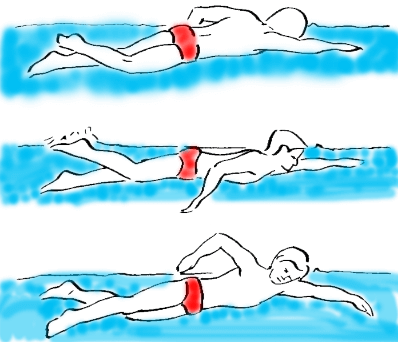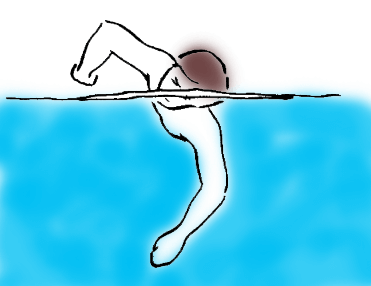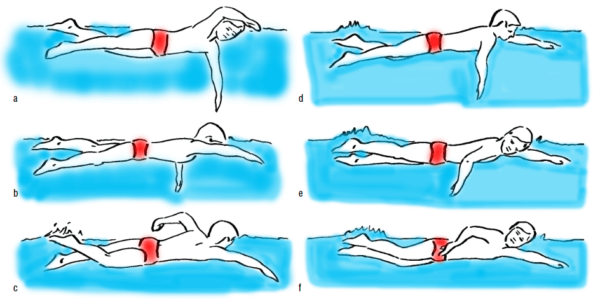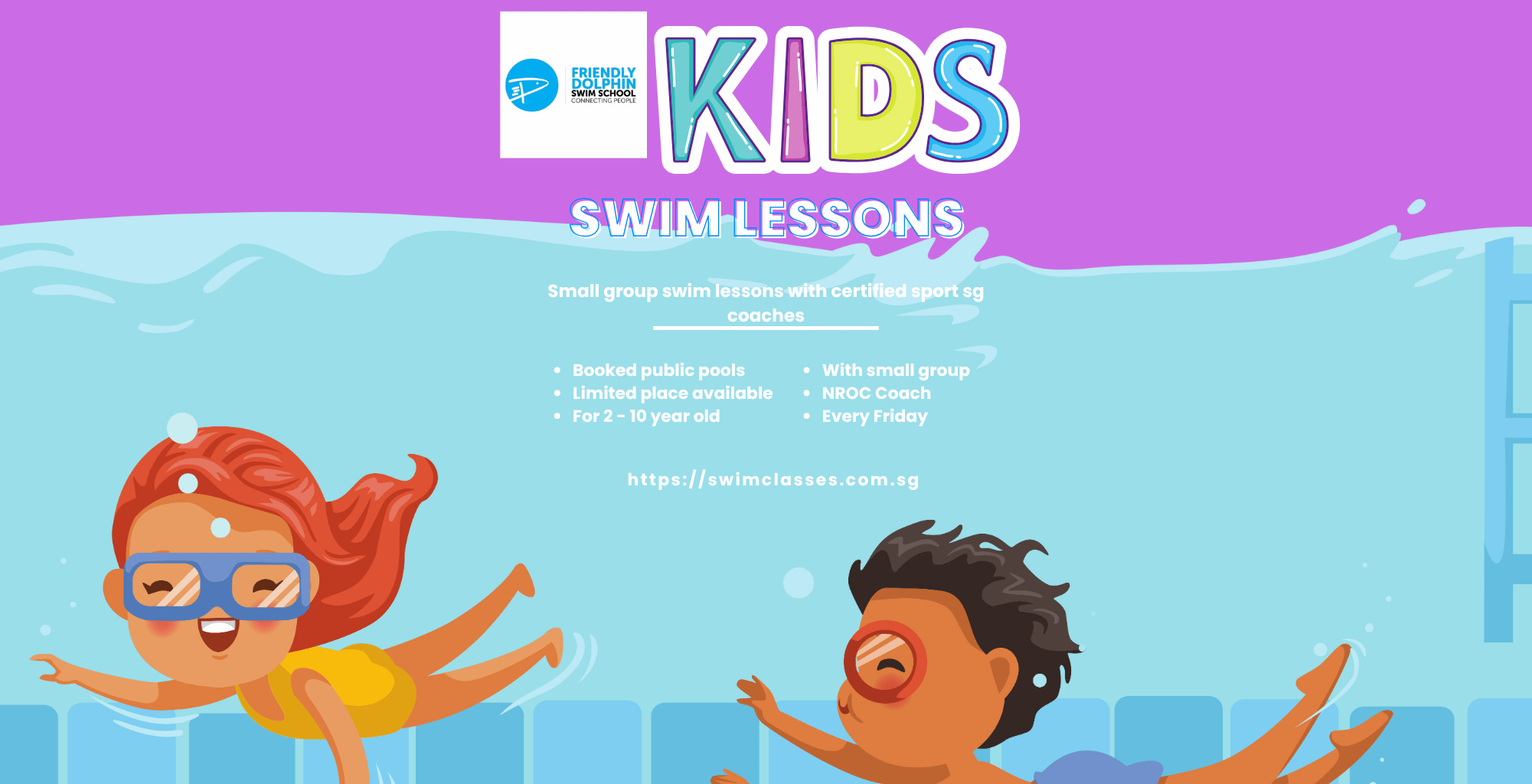Powerful Tips to Master Freestyle Swimming
Many people flood their minds with information without sifting out the useful ones.
(This is a common issue for practically everyone studying freestyle swimming methods, exercises, or stroke adjustments.)
Focus on the essentials rather than attempting to experiment with everything at once.
With our extensive yet simple pictures, this tutorial will help you learn all of the basic aspects in a few of months.
The proper method for learning freestyle swimming strokes.
10 Things to Remember When Practicing Freestyle Strokes
Figure 1: Front crawl head position:

Head Position
When it comes to swimming efficiently in water, body position in the water and excellent head positioning are crucial.
I’m looking forward to seeing your hairline on the surface of the water in front of you (always make sure that your forehead is just below the surface of the water).
Always keep the neck and upper back muscles relaxed. Assuming your torso is parallel to the water, and your hips are raised, your brow should be tilted forward at a 45-degree angle.
If you “bury” your head during the swim, this self-destructive action will add 25 pounds of resistance.
This will cause your body posture in the water to alter. It will make the upper body drop lower, and the hips sink deeper.
Instead, this is detrimental to swimming because it disrupts the streamlined swimming position.
Looking too far creates resistance, and the neck and upper muscles may experience tiredness and discomfort more quickly.
Figure 2

Figure 3 as illustrated a,b.c,d,e,f sequence

Forward Reaching and Arm Action
Every stroke ensures that your arms are extended as far forward as possible, extending your arm to its utmost extent. Most swimmers will concentrate on putting their hands in the water in front of them and then beginning the underwater pull.
Instead, carefully extend your hand 35 cm first, then slowly extend and reach forward 15 cm farther by extending your arm from your shoulder.
The shoulder movement (imagine standing and attempting to reach for a ceiling that is out of reach) can help to improve the length and maximize the efficiency with more smooth strokes and increased efficiency.
Swimming Freestyle – Arm Action
The arms provide the majority of the propulsion force in the front crawl. The entire activity is alternating and continuous.
- The hand is placed in front of the head, ideally parallel to the shoulders.
- The arm is slightly flexed at the elbow in this position to allow for a downward slant from the elbow to the wrist.
- The fingertips enter first, then the wrist, then the elbow, until the catch position is reached.
- This is the place on the water where a buy is made, about 15 cm below the surface (Figure 3b).
- The arm then pulls primarily downward and backward, with the elbow held high (Figure 3c).
- Pulling becomes pushing when the hand and arm are in line with the shoulders (Figure 3d).
- Propulsion is completed when the hand is pressed rearward to brush the thigh (Figures 3e & 3f).
- The arm’s recovery over the water should be smooth and continuous.
- The arm is pulled from the water first, elbow first (Figure 3e).
- The elbow is kept high, and the arm relaxed as it is pushed back to the entering position in a reasonably straight line (Figure 3a).
Body Turning
Body rotation is another common mistake that swimmers make before learning the freestyle strokes. This is related to extending forward with each stroke and turning your body.
In addition, by turning your body with each stroke, you will aid in the extension of your shoulders at the end of each stroke.
Your torso should be turned to the right when your right arm is completely extended in front of you and your left hand is about to exit the water behind you for recovery.
This also implies that the entire right side of the body is submerged in water and facing the pool’s bottom, while the entire left side is breaching towards the sky or the ceilings.
- Following the next stroke, your body will pivot slightly to the left, around 120 degrees. Imagine yourself as a rotisserie lamb pivoting on the axis of the spit; this is also how your body should spin with each freestyle stroke.
“Hourglass” pulling in the water.
When doing the pull in the water, you must ensure that the maximum volume of water is pulled and pushed to the back. A straight line will be the shortest distance between the starting and ending points before your hand exits the water.
This explains why dragging your hand inside the water in a straight line is the last thing you want to do in the water. Instead, practice every freestyle stroke in the water by completing an ‘S’ shape pull, which is a long method to finish every freestyle stroke.
And, from the top, if you draw both arms together at the same time, it will resemble an hourglass. This concurrent outline will also serve as the shape or template for preparing oneself for a butterfly stroke.
Stroke completion and recovery
Even the best swimmers will reduce portions of their strokes and only reach the waistline when weary. They will take their hands out of the water from the waist rather than the upper thigh.
As you finish the hourglass underwater pull, your arms should be fully stretched behind you. Hands should be by your side, with the thumbs grazing the side of your thighs beneath the suit line.
Many swimmers start bending their elbows toward the conclusion of the stroke and lifting their arms out of the water before they can finish their courses longer.
- Shortening strokes cause swimmers to lose efficiency while also consuming more energy because each lap requires more strokes to finish.
Flutter kicking and sprinting
Kicking is one of the most energy-intensive activities in the water, which is why it is frequently relegated until the final lap of any event, particularly a distance event.
Sprinters rely more heavily on kicking; regardless of specialty, developing and acquiring a kicking style that works for you is always necessary.
Unfortunately, most swimmers end up creating unneeded and extra resistance with an improper kick, which usually helps to slow them down!
In freestyle swimming, a good sprint flutter kick should have a quick underwater up and down undulating motion with both feet alternating.
Make as little white water as possible and keep your feet buried. As your body rotates to each side, so should your feet. To maintain proper balance while you spin your body from side to side, do not extend your feet apart horizontally.
Keep your feet in line with the rest of your body to prevent breaking out of the small route your head and shoulders cut through the water.
Train with a hoola hoop first, and then simulate swimming through a tire when you’re more advanced, keeping your feet as close together as possible as you glide through to avoid hitting the edges.
Distance crossing over kick
Distance kicking is a different kick overall from the sprint flutter kicking. In front crawl swimming, this swimming technique is not meant to propel you forward.
The kicking action is meant to keep your rhythm while also assisting to help you keep afloat.
In long distances races, attempting to do a sprint flutter kick will lead to high energy consumption. It eventually crash and burn your body and your mental self with oxygen depletion.
In long races such as those participating by the triathlon, it is best practicing and maintaining a crossover kick. This exercise is done when you do a crossing of ankles with each and every other kick.
Crossover kicks require a lot of practice initially and saves you tons of energy. The kicking actions may come naturally to some swimmers and seeming extremely unnatural to others.
Most of the sprinter swimmers will be more prone, gravitated to perform sprint flutter kicks due to normal instincts. While distance swimmers will always find themselves crossing over during freestyles.
In any way, practice and concentrate on what comes naturally to you first. After that, then try the different techniques and see how it all fares and feels for you.
Keep in mind that the crossover kicking techniques are less taxing on your energy bank and less physically exerting for long events, so usually not as effective when using it as a means to propulsion.
However, it does keep you going longer with the effects of conserving more energy during long endurance events and useful to keep your lower body afloat.
Breathing head position
When doing a turn for your head to breathe.
Always make sure to turn the head 90 degrees to the side.
Many of the swimmers will commit mistakes of turning their heads. Usually, more than 90 degrees and more common at 100 degrees to take a breath.
This action itself will cause their entire face and both eyes to go up above the water’s surface.
You have to try to keep your head parallel to the surface with one eye above and the other eye submerged.
Turning your head more than it is necessary will requires more effort. This results in an increased resistance as the body balance goes out of control every single pivoted turning.
Also always take note of not lifting your head too much forward to breathe.
Most novice swimmers commit mistakes like lifting their heads up and over rather than just staying to the side.
Always remember lifting your head is like using your face to put on brakes and break the momentum. You create more resistance while also put more strains on the neck muscles.
Always practice right breathing pattern
In freestyle swimming, it is good to practice breathing on both sides. This breathing from both sides need to follow good timing and is also known as the bilateral breathing. This breathing pattern will serve to even out your strokes and keep the body balanced in the water.
Swimmers who tend to only breathe to one side during swims tend to have an uneven turnover. They miss out on a lot of views on what their competitions are doing on their blindsides.
This will also decrease their tendency to swim in an arc shape rather than a straight line in the open water.
Extreme cases of breathing from one side causes swimmers with slight curvature of the spine (scoliosis) over time. Teach yourselves to become a bilateral breather, there are no cons in learning to do so.
Freestyle Swimming Breathing Technique
Figure 4

- To allow a breath to be taken, the head is turned so that the mouth clears the water.
- This movement needs to be as smooth as possible and carried out with the minimum of rotation in order to maintain a balanced and streamlined position.
- Though swimmers may inhale on either side, they usually have a preferred side to which they turn.
- The timing of the in-breath is very important and normally occurs as one arm is starting to pull and the other arm is about to recover (Figure 4).
- The type of breathing used by most swimmers is called trickle breathing. After a quick but full inhalation through the mouth, the breath is held briefly and is exhaled slowly through the mouth and nose into the water when the head has been returned to its normal position (Figure 5).
- Breathing may be unilateral on one side only or bilateral on alternate sides.
Freestyle Swimming – Starting and Finishing is important
Figure 5

During casual swimming, most people will disregard the taking off and the finishing. Always remember and keep that in mind that when pushing off the wall for a set of repetitions. Take the time to streamline your arms clasped behind your head in a v shape with your hands together.
Finishes each of the repeat with stroke to the wall. Do not slow down and coast in with your heads raised like what we usually do.
Keep in mind that the more you maintain streamline, the less you have to swim on the given lap. Always try to ensure that you are swimming near the water surface instead of underwater.
Coordination
The timing of leg and arm actions usually occurs quite naturally.
The most common pattern in the front crawl is that of six leg kicks to each arm cycle. (Example: the complete actions of both left and right arms.)
As one arm is pulling, the opposite leg should be kicking downward.
If you wish to learn and read more about learning freestyle swimming and it’s origin.
Read more: Freestyle Swimming
If still after practicing ownself and find no progressions. And wish to take up corrections on better learning how to swim freestyle the right way through guided instruction. You can check also check us out via swimming lessons to learn more.


